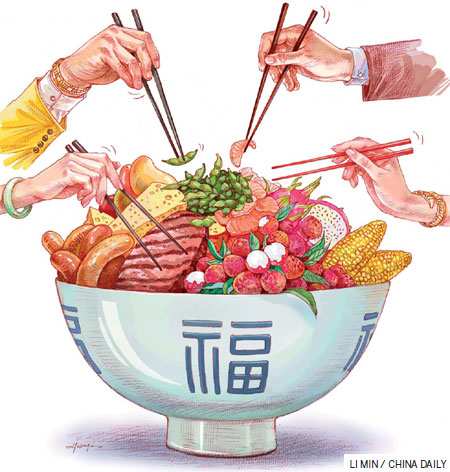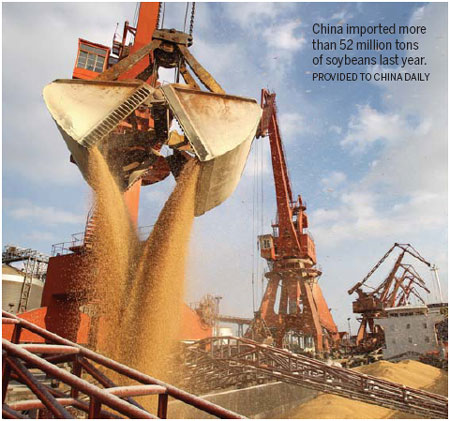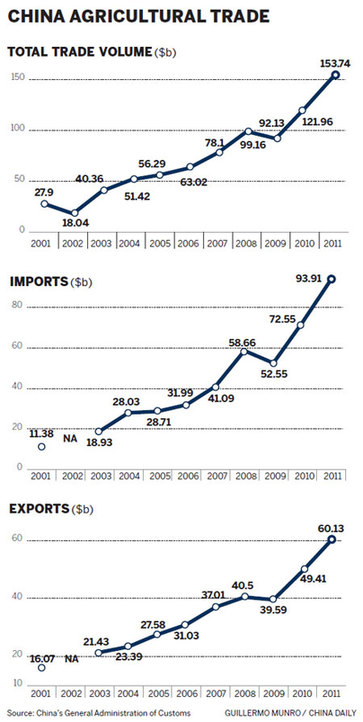A lot on the plate
Updated: 2012-03-30 09:05
By Lu Chang (China Daily)
|
|||||||||

China's growing demand offers MANY opportunities for overseas livestock, grain traders
Chicken feet, pig knuckles or cow tripe are hardly items that set the cash registers ringing at the export turnstiles. But in the global food markets it is these leftover animal parts that are shaping the market trends as strong demand from China is providing the much-needed prop to meat and grain farmers.
|
||||
Despite its humble nature, imports of pig offal - including pig's head, knuckles and tough, often served as a cold/fun snack with beer - stood at some 882,200 tons in 2011 and accounted for more than 65 percent of the total pig products imported in China.
Along with its robust economic growth and dietary enrichment, demand for meat has also been growing steadily in China. The nation is one of the largest consumers of pork in the world and its huge demand had a cascading effect on animal feed prices last year, particularly that of corn and soybean.
In 2011, China imported agricultural products worth nearly $95 billion (71 billion euros), compared with just $12 billion in 2001. The 2011 figures also represented a 30 percent year-on-year growth, according to the statistics provided by the Ministry of Agriculture.
Along with the rising trade volumes, there has also been a growing trade deficit in the agricultural sector. In 2011, the trade deficit rose 47.4 percent to $34 billion, whereas in 2004, China was still a net agricultural exporter.
"China will become the world's largest agricultural product importer within the next five to 10 years," says Cheng Guoqiang, a senior researcher with the Development Research Center of the State Council.
China is already the world's largest importer of soybean and cotton, and has become the largest agricultural export market for the US since 2010, with a total value tripling over the past six years to $17.8 billion. High on China's list of imports from the US are corn, soybean, cotton and processed animal feed.
But countries with vast arable land for expansion, such as Brazil and Argentina, are also racing in to meet demand from China.
China imported 19.8 million tons of soybeans from Brazil last year, accounting for 38 percent of the total imports of 52 million tons from all sources. This helped Brazil surpass the US as the biggest soybean exporter to China.
Cheng says that rising incomes and the growing number of middle-class people in China are contributing to a growing demand for food imports. "More than 1 million people every year move into the middle class segment in China. The higher disposable income will help them to buy more meat, oil and milk. So it is quite natural that food imports will continue to grow," he says.
Another reason why China needs to import more agricultural goods is that the increased output of meat and grains will lead to a decrease in the amount of arable land, water supplies and other natural resources. Grain imports are often seen as a better approach for the wiser use of environmental resources.
"I don't think self-sufficiency is something that holds in good stead nowadays, as the world is more developed and countries more specialized in what they can produce with good value for the global society," says Marcos Neves, professor of strategic planning and food chains at the School of Economics and Business, University of Sao Paulo in Brazil.
"Development in China requires a tightrope walk between green causes and the need to secure food supplies for the growing masses," Neves says. "Take Brazil, for instance. It is already the largest food exporter, and has at least 100 million hectares that can be used for agriculture and biofuel production, in a sustainable manner, being able to supply the needs of China in a safe and reliable way."
Li Guoxiang, a senior researcher on rural development from the Chinese Academy of Social Sciences (CASS), expects a golden window of 5-10 years for food imports, considering that the nation has some $3 trillion in foreign exchange reserves, and a strong purchasing ability for imports, coupled with healthy trade balances.
But of late there has been considerable speculation in the international trade community that China's inability to feed itself may have long-term consequences on the global food system. Some experts have even predicted that increased imports may lead to global food shortage and even hunger.
Minister of Agriculture Han Changfu had earlier remarked that China's grain imports are primarily to enrich crop varieties in the domestic market, and stressed that the nation "will not and cannot" rely on imports to feed its 1.3 billion population.
China feeds more than 20 percent of the world's population despite having less than 10 percent of the world's agricultural land and less than 6 percent of the water resources. The government has reiterated that it intends to meet about 95 percent of its food requirements from domestic sources.
Li says China accounts for a very small share of the global grain imports, and hence hardly in a position to shape global grain market trends, and least of all hunger in some less developed countries.
"It is actually a win-win situation rather than some evidence of a faltering agricultural sector," he says.
"On the one hand, increasing agricultural imports will help China ease pressure on natural resources and increase the country's grain security," Li says. "But at the same time, the growing demand for farm food consumption also creates opportunities for international food manufacturers, as the unit prices increase in tandem with consumption patterns."
 |
Not just tofu
Soybean imports by China are expected to maintain an uptrend in the next 10 to 15 years with growth being driven primarily by the demand from urban residents.
"Soybean imports are expected to grow substantially in the long term propelled by growing demand for oil and livestock feed," says Ma Wenfeng, a senior analyst at Beijing Orient Agribusiness Consultant Ltd, a major agricultural consultancy.
 |
According to a US Department of Agriculture forecast, China's total imports of soybean are expected to go up by 62 percent to 90 million tons over the next 10 years.
"Soymeal, produced in China largely from imported soybeans, is an integral protein component of the feed necessary to support China's burgeoning pork, poultry and aquaculture industries," said the US Department of Agriculture (USDA) in its first forecast 2012-13.
"Their rapidly maturing animal husbandry and feed industries, including aquaculture, expansion in crushing capacity and growing consumption of vegetable oils are all driving demand which cannot be met by domestic supplies."
In recent years, each person in China has been consuming 5 percent more meat, 10 percent more milk, and 8 percent more cooking oil annually compared to five years ago, figures from the National Bureau of Statistics showed.
China is the largest importer of US soybean, and buys a quarter of the country's soybean production. In February, when Vice-President Xi Jinping made a visit to the US, a Chinese trade delegation signed a deal to buy US soybeans with a total value of $4.31 billion and volume of 8.62 million tons.
The nation became a dominant force in the international soy markets in the late 1990s and is now the world's largest importer and consumer, taking in some 55 million tons in 2010 mostly from the US and Brazil, more than 50 percent of the annual global trade. Total soybean consumption has risen 64 percent since 2005, but the self-sufficiency rate stands at only about 20 percent, according to data from the General Administration of Customs.
Ma says it is more efficient for China to import soybeans than to produce them, as soybean production needs more land and water supplies.
"China will be more susceptible to price fluctuations in the international food market with more soybean imports," he says. "But during unfavorable weather conditions, the soybean imports will keep the country insulated from international speculation and food-price fluctuations in the global market."
Corny issue
For many agricultural exporters, China's soybean imports have already become a stable market that offers steady growth prospects. But the bigger question now is whether the soybean scenario will become the trendsetter for corn also.
China was largely self-sufficient in corn until 2010, when corn imports climbed to 1.57 million tons, a 17-fold increase year-on-year. In 2011, corn imports rose 11 percent to 1.75 million tons, with 1.68 million tons coming from the US, the world's largest corn producer and consumer, according to data from the Customs.
China is also turning to other markets for corn imports. Earlier this year, China signed a deal to buy corn from Argentina, a potential alternative corn supplier to the US, according to a statement from Argentina's agriculture ministry.
It projected that China will become "a significant importer" in the coming years with corn imports expected to reach 3 million tons.
Driving this dramatic change in the corn industry is the world's most populous country's accelerated urbanization and industrial consumption, analysts say.
At the end of last year, the urban population outstripped that in rural areas for the first time, accounting for 51.27 percent of the total, according to the National Bureau of Statistics.
Sam Niu, assistant director of the US Grains Council in Beijing, a non-profit market development organization, says more than 70 percent of the imported corn is being used in the Chinese deep-processing industries of animal feed, ethyl alcohol and starch. Though China has a deep-processing capability of 700 million tons, its actual consumption is only 400 to 500 million tons, leaving further room for growth.
"Currently, the consumption has grown so fast that China's corn production may not be able to keep pace with the demand, with most of the imports being used to build up the national grain reserves," Niu says. "China will have to import more than 10 million tons in the next five years to address the imbalances."
Even though all signs indicate that China is going to enter the global corn market in a substantial manner, experts say corn imports might not reach the same scale as that of soybean.
"China's imports of corn are unlikely to grow like the soybean trade, as it will not rely on large volumes of imported corn, which will also put higher risks on secure food supplies," says Zhang Qi, an analyst at Yigu Information Consulting Ltd, the biggest corn-information website by readership. "Unlike soybean production that has not changed for the past decade, the corn yields per hectare have been increasing every year and imports will account for only a small part."
The nation's 2011 corn harvest hit a record 192 million tons, up 8.2 percent year-on-year. Total grain output increased 4.5 percent to 571 million tons in 2011, official data shows.

 Relief reaches isolated village
Relief reaches isolated village
 Rainfall poses new threats to quake-hit region
Rainfall poses new threats to quake-hit region
 Funerals begin for Boston bombing victims
Funerals begin for Boston bombing victims
 Quake takeaway from China's Air Force
Quake takeaway from China's Air Force
 Obama celebrates young inventors at science fair
Obama celebrates young inventors at science fair
 Earth Day marked around the world
Earth Day marked around the world
 Volunteer team helping students find sense of normalcy
Volunteer team helping students find sense of normalcy
 Ethnic groups quick to join rescue efforts
Ethnic groups quick to join rescue efforts
Most Viewed
Editor's Picks

|

|

|

|

|

|
Today's Top News
Chinese fleet drives out Japan's boats from Diaoyu
Health new priority for quake zone
Inspired by Guan, more Chinese pick up golf
Russia criticizes US reports on human rights
China, ROK criticize visits to shrine
Sino-US shared interests emphasized
China 'aims to share its dream with world'
Chinese president appoints 5 new ambassadors
US Weekly

|

|










